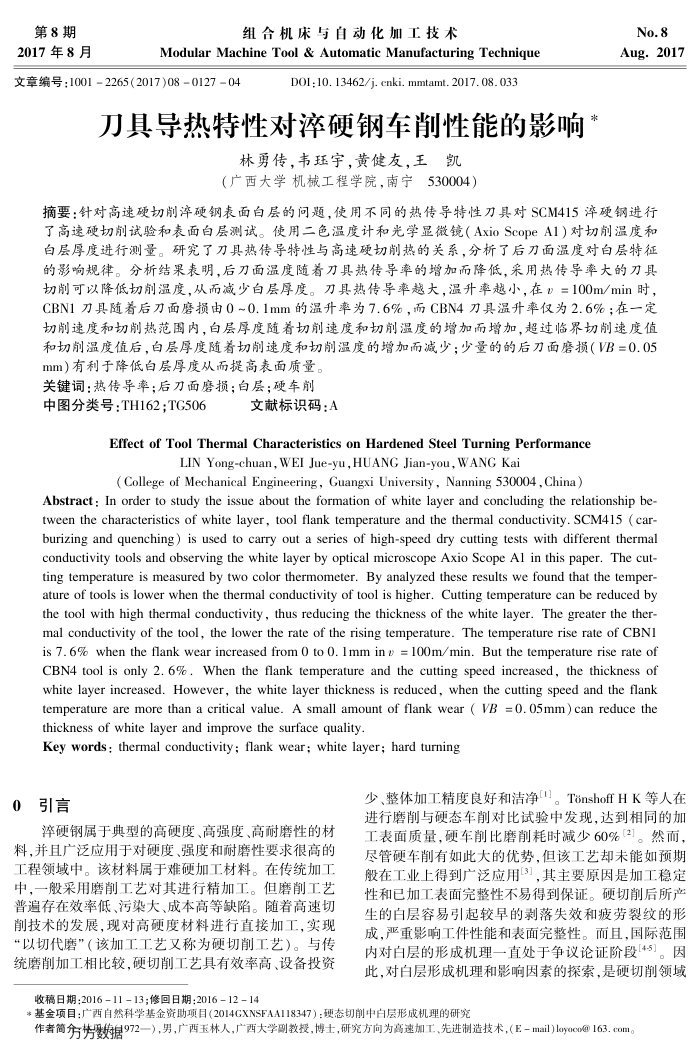您当前的位置:首页>论文资料>刀具导热特性对淬硬钢车削性能的影响
内容简介
 第8期 2017年8月
第8期 2017年8月组合机床与自动化加工技术
Modular MachineTool &Automatic Manufacturing Technique
文章编号:10012265(2017)08012704
D0I:10.13462/j. cnki. mmtamt.2017.08.033
刀具导热特性对淬硬钢车削性能的影响
林勇传,韦宇,黄健友,王凯(广西大学机械工程学院,南宁530004)
No.8 Aug.2017
摘要:针对高速硬切削率硬钢表面白层的问题,使用不同的热传导特性刀具对SCM415泽硬钢进行了高速硬切试验和表面白层测试。使用二色温度计和光学显微镜(AxioScopeA1)对切削温度和白层厚度进行测量。研究了刀具热传导特性与高速硬切削热的关系,分析了后刀面温度对白层特征的影响规律。分析结果表明,后刀面温度随着刀具热传导率的增加而降低,采用热传导率大的刀具切削可以降低切削温度,从而减少白层厚度。刀具热传导率越大,温升率越小,在=100m/min时, CBN1刀具随着后刀面磨损由0~0.1mm的温升率为7.6%,而CBN4刀具温升率仅为2.6%;在一定切削速度和切削热范围内,白层厚度随着切削速度和切削温度的增加而增加,超过临界切削速度值和切削温度值后,白层厚度随着切削速度和切削温度的增加而减少;少量的的后刀面磨损(VB=0.05
mm)有利于降低白层厚度从而提高表面质量。关键词:热传导率:后刀面磨损;白层;硬车削
中图分类号:TH162;TG506
文献标识码:A
Effect of Tool Thermal Characteristics on Hardened Steel Turning Performance
LIN Yong-chuan, WEI Jue-yu, HUANG Jian-you, WANG Kai
( College of Mechanical Engineering, Guangxi University, Nanning 530004, China)
Abstract : In order to study the issue about the formation of white layer and concluding the relationship be tween the characteristics of white layer, tool flank temperature and the thermal conductivity. SCM415 (car-burizing and quenching) is used to carry out a series of high-speed dry cutting tests with different thermal conductivity tools and observing the white layer by optical microscope Axio Scope Al in this paper. The cut-
ature of tools is lower when the thermal conductivity of tool is higher. Cutting temperature can be reduced by the tool with high thermal conductivity , thus reducing the thickness of the white layer. The greater the ther-mal conductivity of the tool, the lower the rate of the rising temperature. The temperature rise rate of CBNI is 7. 6% when the flank wear increased from 0 to 0. 1mm in = 100m/min. But the temperature rise rate of CBN4 tool is only 2. 6%. When the flank temperature and the cutting speed increased, the thickness of white layer increased. However, the white layer thickness is reduced, when the cutting speed and the flank temperature are more than a critical value. A small amount of flank wear ( VB =0. 05mm)can reduce the thickness of white layer and improve the surface quality-
Key words: thermal conductivity; flank wear; white layer; hard turning
引言 0
率硬钢属于典型的高硬度、高强度、高耐磨性的材料,并且广泛应用于对硬度、强度和耐磨性要求很高的工程领域中。该材料属于难硬加工材料。在传统加工中,一般采用磨削工艺对其进行精加工。但磨削工艺普追存在效率低、污染大、成本高等缺陷。随着高速切削技术的发展,现对高硬度材料进行直接加工,实现“以切代磨"(该加工工艺又称为硬切削工艺)。与传统磨削加工相比较,硬切削工艺具有效率高、设备投资
少、整体加工精度良好和洁净]。TonshoffHK等人在进行磨削与硬态车削对比试验中发现,达到相同的加工表面质量,硬车削比磨削耗时减少60%(2]。然而,尽管硬车削有如此大的优势,但该工艺却未能如预期般在工业上得到广泛应用3],其主要原因是加工稳定性和已加工表面完整性不易得到保证。硬切削后所产生的白层容易引起较早的刺落失效和疲劳裂纹的形成,严重影响工件性能和表面完整性。而且,国际范围内对白层的形成机理一直处于争议论证阶段145]。因此,对白层形成机理和影响因素的探索,是硬切削领域
收稿日期:2016-11-13;修回日期:2016-12-14
*基金项目:广西自然科学基金资助项目(2014GXNSFAA118347):硬态切前中白层形成机理的研究
作者简务势数据972—),男,广西玉林人,广西大学副教授,博士,研究方向为高速加工、先进制造技术,(E-mail)loyoeo@163.com。